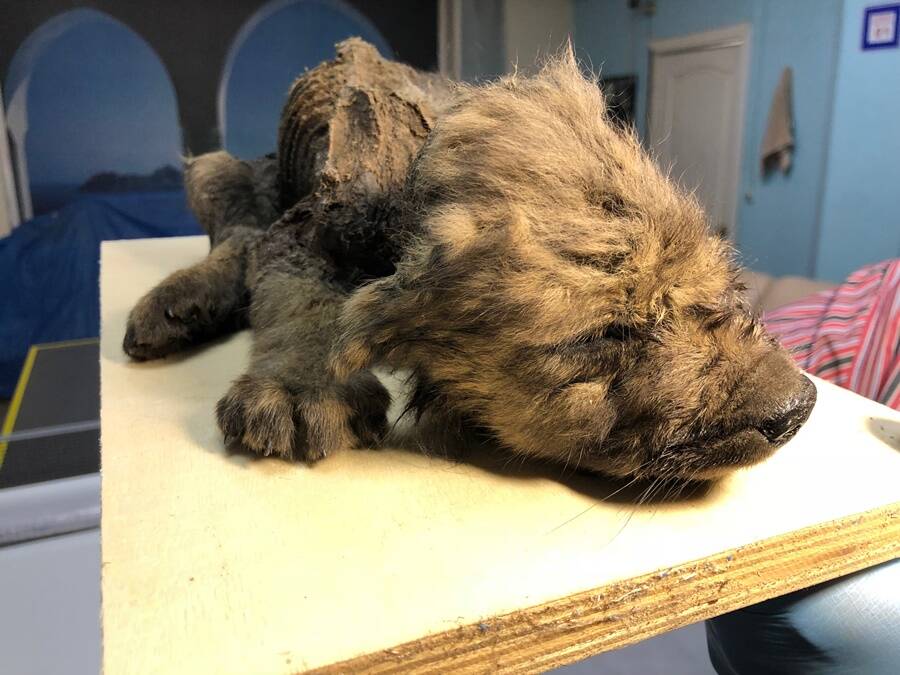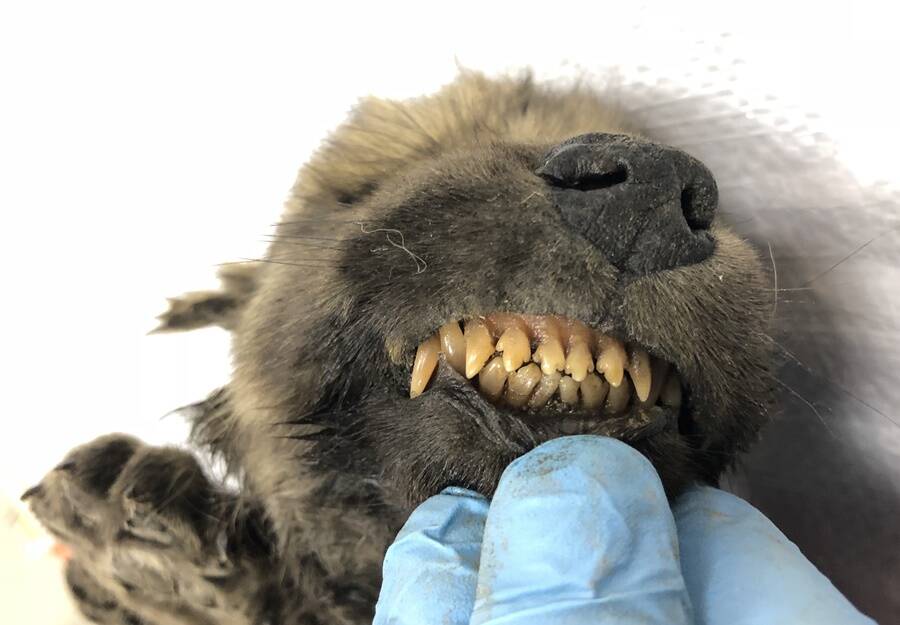"The fact that we can't [determine whether it's wolf or dog] might suggest that it's from a population that was ancestral to both — to dogs and wolves."

Centre for Palaeogenetics/TwitterScientists have named the 18,000-year-old mummified mutt Dogor, which means “friend” in Yakutian.
A recent discovery has left researchers bewildered. An 18,000-year-old mummified corpse of a puppy was found buried under the Siberian permafrost, but analysis of the incredibly well-preserved remains have suggested that the animal is neither dog nor wolf — meaning it could actually be a common ancestor for both.
According to CNN, Russian scientists unearthed the canine corpse near Yakutsk, located in eastern Siberia. Like many past archaeological discoveries uncovered from the depths of the permafrost, the mummified pup was mostly intact with its nose, fur, and teeth remarkably well-preserved.
Researchers from Sweden’s Centre for Palaeogenetics (SCP) took a sample of the animal’s rib bone and used carbon dating to determine that it had been buried underneath the frozen tundra for roughly 18,000 years. They were also able to establish that the animal was a male.
The team named the frozen pup Dogor, a Yakutian word that translates to mean “friend.” But was Dogor really man’s best friend or was he still a wild animal? Researchers aren’t quite sure: a genome sequencing on the puppy’s DNA revealed something astonishing — researchers couldn’t determine whether the puppy was a dog or a wolf.
David Stanton (@Nibbledtodeath) from the Centre for Palaeogenetics (@CpgSthlm) tells @bevvo14 what they can learn from examining the perfectly preserved body of a puppy believed to be more than 18,000 years old… #Dogor #TheWorld pic.twitter.com/qi37i6zy7n
— ABC News (@abcnews) November 28, 2019
In past discoveries of similar canine corpses, it’s usually very easy to find out which side of the canine line of evolution the animal falls on. Dogor, however, is different. The anomaly could mean that the puppy came from “a very interesting time in terms of wolf and dog evolution.”
“We don’t know exactly when dogs were domesticated, but it may have been from about that time,” SCP researcher David Stanton told CNN. “We are interested in whether it is in fact a dog or a wolf, or perhaps it’s something halfway between the two.”
Stanton added that the well-preserved body has supplied researchers with enough material to work on but they will need to run more tests to figure out where exactly Dogor belongs in the canine evolution timeline.
“We have a lot of data from it already, and with that amount of data, you’d expect to tell if it was one or the other. The fact that we can’t might suggest that it’s from a population that was ancestral to both — to dogs and wolves,” Stanton said.
Modern dogs are believed to be the descendants of domesticated wolves but scientists have yet to determine when that transition from wild animal to domesticated pet occurred in history. However, a 2017 study in the journal Nature Communications did find that our modern pet dogs were likely domesticated from a single population of wolves some 20,000 to 40,000 years ago.
Yakutsk, where Dogor’s mummified body was found, is a city in eastern Siberia. It is said to be the coldest city on Earth, with average temperatures dipping to a ridiculously-low minus 34 degrees Fahrenheit in January.

Centre for Palaeogenetics/TwitterConditions inside the Siberian permafrost enabled the specimen to remain remarkably intact.
The Siberian permafrost — which includes parts of northern Canada, Alaska, and Greenland — has been a treasure trove of archaeological finds in the past. Thanks to the deep-freeze conditions underneath, many of these historical treasures include wholly-intact animal corpses dating back to prehistoric times.
In June, researchers revealed a 40,000-year-old whole wolf head from the Pleistocene era found in Siberia. In 2017, the preserved remains of an ancient cave lion cub was discovered around the same place.
These discoveries could mean more than just learning about the ancient animals that used to roam the Earth. Earlier this year, scientists successfully extracted the blood and urine of a perfectly preserved foal corpse dating back to 42,000 years ago. The team is hoping to clone the now-extinct horse species using the bio-materials harvested from the mummified corpse.
For now, researchers who are studying the wolf-dog specimen are continuing their work to determine Dogor’s ancestry and hopefully unlock the mystery of the wolf-to-dog evolution.
Next, check out these mummies of an Ice Age wolf pup and caribou with their skin and fur intact and the “Siberian Unicorn” discovery that shocked scientists.





